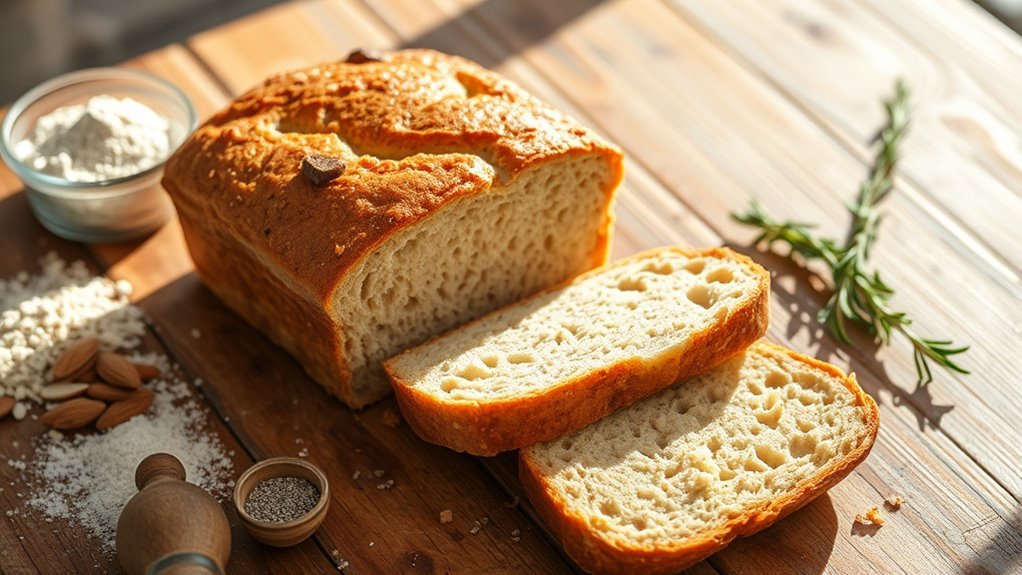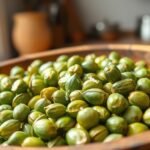Keto bread is typically gluten-free since it uses alternative flours like almond or coconut flour, which don’t contain gluten. While popular brands often emphasize their gluten-free status, it’s important to check for gluten-free certifications to avoid cross-contamination. Many people prefer keto bread for its low carbohydrate content, making it a great choice for those on a keto diet. If you’re interested in making your own or learning about popular brands, keep exploring more information on this topic.
Understanding Keto Bread Ingredients
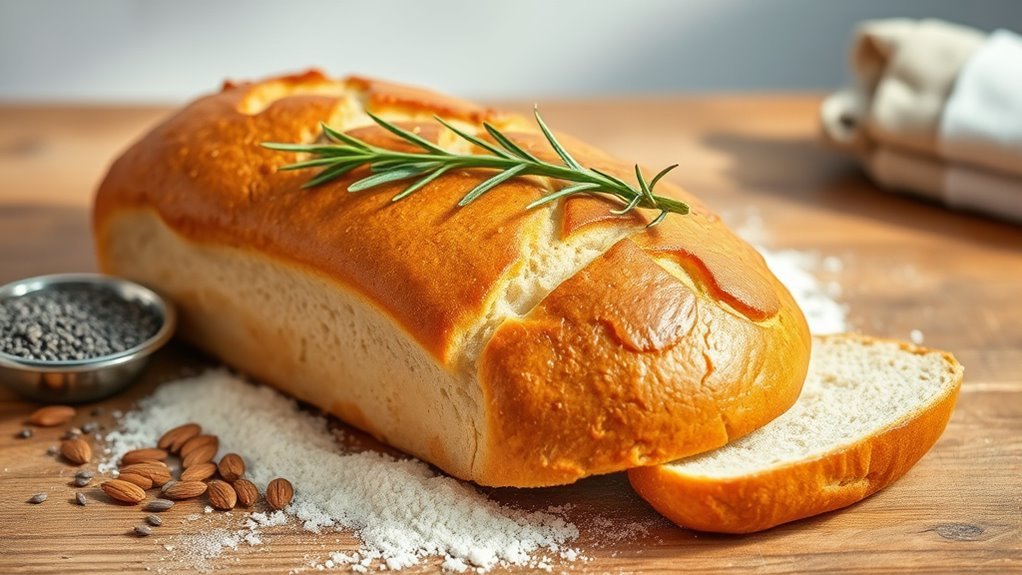
When you’re exploring keto bread, it’s essential to understand the ingredients that set it apart from traditional bread. Keto bread typically uses ingredient types like almond flour, coconut flour, or flaxseed meal instead of wheat flour. These alternatives greatly reduce carbohydrate content while providing nutritional benefits, such as healthy fats and fiber. You’ll also find ingredients like eggs and cheese, which add moisture and structure, enhancing the overall taste and texture. Baking techniques for keto bread often differ as well, requiring specific methods to achieve the desired rise and consistency. By knowing these components, you can appreciate how keto bread caters to a low-carb lifestyle while still offering a satisfying alternative to conventional bread. Additionally, the use of binding agents like psyllium husk helps improve the bread’s texture and overall integrity.
The Role of Gluten in Traditional Breads
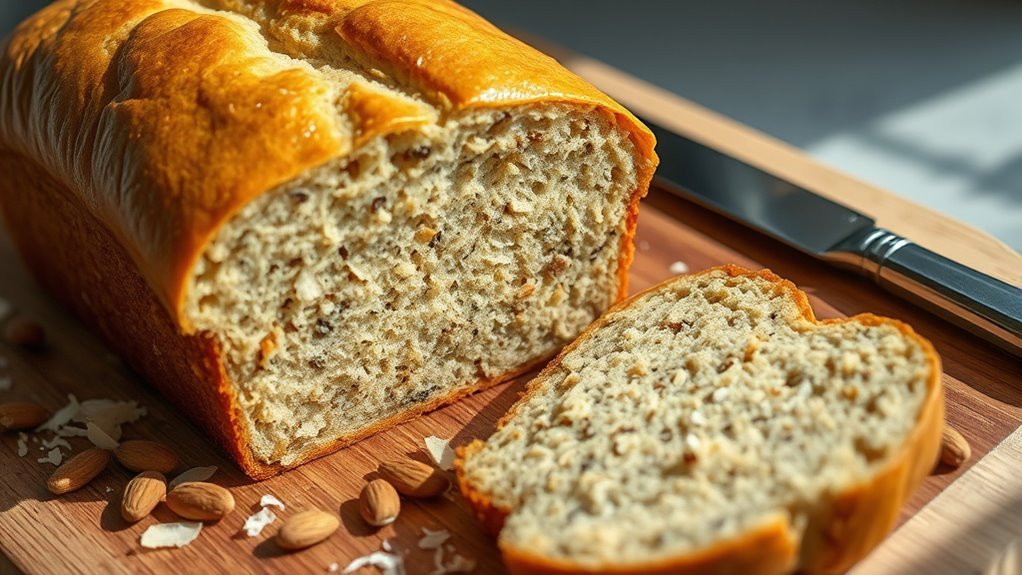
When you think about traditional breads, gluten plays an essential role in their structure and texture. It helps trap air bubbles during fermentation, giving bread its characteristic rise and chewiness. However, gluten can also pose health challenges for some individuals, leading to the popularity of gluten-free alternatives.
Gluten’s Function in Bread
Gluten plays an essential role in the structure and texture of traditional breads, acting as a natural binder that provides elasticity and strength. When flour is mixed with water, gluten proteins form a network, creating a unique gluten structure that traps air bubbles during fermentation. This process contributes to the bread’s rise and chewy texture. The gluten properties, such as elasticity and extensibility, allow the dough to stretch without tearing, ensuring it holds its shape while baking. Without gluten, bread would lack the desired volume and texture, resulting in a dense product. Understanding these functions helps you appreciate why traditional bread has such a distinct character, which is often absent in gluten-free alternatives.
Health Impacts of Gluten
How does gluten affect your health? For many, gluten is a harmless protein found in traditional breads, but for those with gluten sensitivity, it can trigger digestive issues like bloating, diarrhea, and abdominal pain. This sensitivity can greatly impact your digestive health, making it essential to recognize your body’s signals. While most people digest gluten without problem, some individuals may experience adverse reactions that affect their overall well-being. It’s also worth noting that gluten can influence gut microbiota, which plays a critical role in digestion and immune function. Understanding your relationship with gluten can empower you to make informed dietary choices, leading to improved digestive health and greater freedom in what you eat. Additionally, it’s important to consider the impact of nutrient-dense foods on your overall health when making dietary decisions.
Gluten-Free Alternatives Available
Although many traditional breads rely on gluten for their structure and texture, a variety of gluten-free alternatives have emerged to cater to those with gluten sensitivities or celiac disease. You can explore gluten-free grains like quinoa, brown rice, and buckwheat, which provide essential nutrients without the adverse effects of gluten. Additionally, keto-friendly flours such as almond flour, coconut flour, and flaxseed meal not only serve as substitutes but also align with low-carb diets. These alternatives allow you to enjoy delicious bread without compromising your health. By incorporating these options, you can maintain a balanced diet while enjoying the freedom to choose what works best for your body, ensuring both taste and well-being in your meals. For those interested in baking, using keto flour options can provide the necessary texture while keeping your carb intake low.
Common Gluten-Free Ingredients in Keto Bread
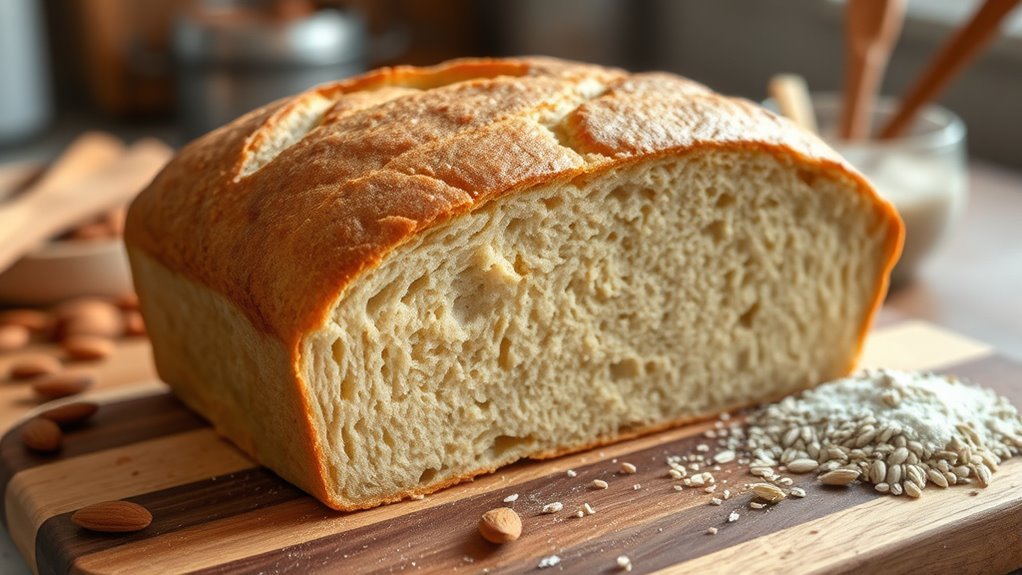
When you’re exploring keto bread options, you’ll find a variety of gluten-free ingredients that not only meet dietary restrictions but also enhance flavor and texture. Almond flour is a popular choice, providing a nutty taste and moisture. Coconut flour, being highly absorbent, adds fiber while keeping carb counts low. Flaxseed meal and chia seeds are excellent for binding, offering omega-3 fatty acids and a nutritious boost. Psyllium husk is often included for its ability to create a bread-like texture, making your loaf more enjoyable. Sunflower seed flour is another alternative, packed with protein and healthy fats. These ingredients combine to create a satisfying keto bread that supports your dietary goals without sacrificing taste. Additionally, incorporating healthy fats can further enhance the flavor and nutritional profile of your keto bread.
Differences Between Gluten-Free and Keto Diets
When comparing gluten-free and keto diets, it’s important to understand their distinct principles and ingredient choices. While gluten-free diets focus on eliminating gluten-containing foods for those with sensitivities, ketogenic diets prioritize low carbohydrate intake to encourage fat burning. By exploring the unique aspects of gluten-free ingredients and keto principles, you can better navigate your dietary options. Incorporating low-carb vegetables can enhance your meals while staying aligned with keto guidelines.
Gluten-Free Ingredients Overview
While many people turn to gluten-free diets for health reasons, it’s essential to understand how these differ from keto diets, particularly regarding ingredient choices. Gluten-free diets primarily focus on avoiding gluten, while keto diets emphasize low carbohydrate intake. Here’s a quick comparison of gluten-free and keto-friendly ingredients:
| Gluten-Free Ingredients | Keto-Friendly Ingredients |
|---|---|
| Gluten free grains (e.g., rice, quinoa) | Almond flour, coconut flour |
| Gluten substitutes (e.g., xanthan gum) | Psyllium husk, flaxseed meal |
| Legumes (chickpeas, lentils) | Cauliflower, zucchini |
| Fruits (bananas, apples) | Avocados, berries |
Understanding these differences helps you make informed choices, whether you’re aiming for gluten-free living or adopting a low-carb lifestyle. Additionally, incorporating keto-friendly ingredients can enhance your culinary options while maintaining dietary goals.
Keto Diet Principles Explained
Understanding the principles of the keto diet is essential, especially since its goals differ greatly from those of a gluten-free diet. While both diets focus on health, they target different aspects of nutrition. Here are some key differences:
- Keto diet basics emphasize high fats and low carbs.
- Low carb principles aim to induce ketosis, a metabolic state that burns fat for energy.
- Gluten-free diets eliminate gluten due to allergies or sensitivities, not necessarily carbs.
- The keto diet can include gluten-free grains, but not all gluten-free foods fit within keto guidelines.
- Caloric intake on a keto diet is often more restrictive compared to gluten-free eating.
- Additionally, the macronutrient ratios in the keto diet are crucial for achieving and maintaining ketosis.
Popular Brands of Keto Bread and Their Ingredients
As you explore the world of keto-friendly diets, it’s essential to know which brands of keto bread can fit seamlessly into your meal plan. Popular brands like Sola and ThinSlim Foods offer low-carb options that typically include almond flour, coconut flour, and crucial wheat gluten. In ingredient comparisons, Sola’s bread contains erythritol, while ThinSlim focuses on fiber-rich ingredients to enhance texture without compromising keto guidelines. Another option is Franz Keto Bread, which boasts a blend of pea protein and oat fiber. Each brand has unique features, so you’ll want to read the labels carefully. By understanding these differences, you can choose keto bread that aligns with your dietary goals while enjoying the freedom of variety in your meals. Additionally, being mindful of carbohydrate content is vital to ensure you stay within your keto limits.
How to Identify Gluten in Keto Products
How can you guarantee that the keto products you choose are truly gluten-free? Identifying gluten in keto products involves a few practical steps. Here’s what to look for:
- Check for gluten detection methods like ELISA.
- Read product labeling standards carefully for “gluten-free” certifications.
- Look for alternative flours such as almond or coconut, which are naturally gluten-free.
- Be aware of cross-contamination warnings, especially in processed foods.
- Research the brand’s commitment to gluten-free practices. Additionally, monitoring carbohydrate intake is crucial for maintaining ketosis, making it essential to ensure that keto products align with your dietary goals.
Benefits of Gluten-Free Keto Bread
Gluten-free keto bread offers a delicious alternative for those following a low-carb lifestyle while also avoiding gluten. This type of bread can provide significant nutritional benefits, often being lower in carbs and higher in healthy fats compared to traditional bread. Ingredients like almond flour and coconut flour not only help maintain a keto diet but also cater to various taste preferences. You can enjoy the satisfaction of bread without the gluten that may cause discomfort or health issues for some. Additionally, gluten-free keto bread tends to be rich in fiber, supporting digestive health. By choosing this option, you’re embracing a versatile and flavorful way to enjoy your meals while staying aligned with your dietary goals. Furthermore, the higher fiber content in keto bread can aid in stabilizing blood sugar levels and improving overall digestive health.
Tips for Making Your Own Keto Bread at Home
Making your own keto bread at home can be a rewarding experience, especially when you realize how simple it is to customize recipes to suit your taste. To achieve the perfect bread texture, consider using various flour alternatives. Here are some tips to get you started:
- Experiment with almond flour or coconut flour for different flavors.
- Add eggs to enhance moisture and binding.
- Incorporate seeds or nuts for added texture and nutrition.
- Use baking powder or baking soda for leavening.
- Don’t forget to season with herbs or spices to elevate taste.
Frequently Asked Questions
Is All Keto Bread Gluten-Free?
Not all keto bread is gluten-free, so you’ve got to check the ingredients! Many brands use gluten-free alternatives like almond flour or coconut flour, which are popular choices among keto enthusiasts. However, some might include gluten-containing components, so read labels carefully. If you’re aiming for a gluten-free diet, opt for breads specifically labeled in this way. This guarantees you enjoy your keto journey without any gluten-related worries. Always prioritize your health!
Can I Eat Keto Bread on a Gluten-Free Diet?
Yes, you can eat keto bread on a gluten-free diet, but it depends on the ingredients used. Many keto bread recipes utilize gluten-free alternatives like almond flour or coconut flour, which are safe for your diet. However, always check the packaging or ingredient list, as some brands might include gluten-containing products. By choosing the right keto bread, you can enjoy a tasty low-carb option while maintaining your gluten-free lifestyle.
How Do I Store Keto Bread?
To store keto bread, keep it in an airtight container at room temperature for up to five days. For longer shelf life, you can refrigerate it, which extends freshness for about a week. If you need to store it even longer, consider freezing slices; they can last up to three months. Just make sure to wrap them well to prevent freezer burn. Proper keto bread storage helps maintain taste and texture while maximizing bread shelf life.
Does Keto Bread Taste Similar to Regular Bread?
Keto bread doesn’t taste exactly like regular bread. For instance, when Jane switched to keto, she found the taste comparison quite different. While some keto breads have a slightly nutty flavor and denser texture, others may mimic traditional bread more closely. You’ll notice texture differences too; keto bread can be a bit crumbly. Ultimately, it depends on the recipe and ingredients used, but it often satisfies the craving for bread without the carbs.
Can I Freeze Keto Bread for Later Use?
Yes, you can freeze keto bread for later use! To maximize bread longevity, wrap it tightly in plastic wrap or aluminum foil, then place it in an airtight container or freezer bag. This helps prevent freezer burn. When you’re ready to enjoy it, just thaw it in the fridge overnight or toast it directly from the freezer. Using these freezing tips, you can keep your keto bread fresh and ready whenever you need it!
